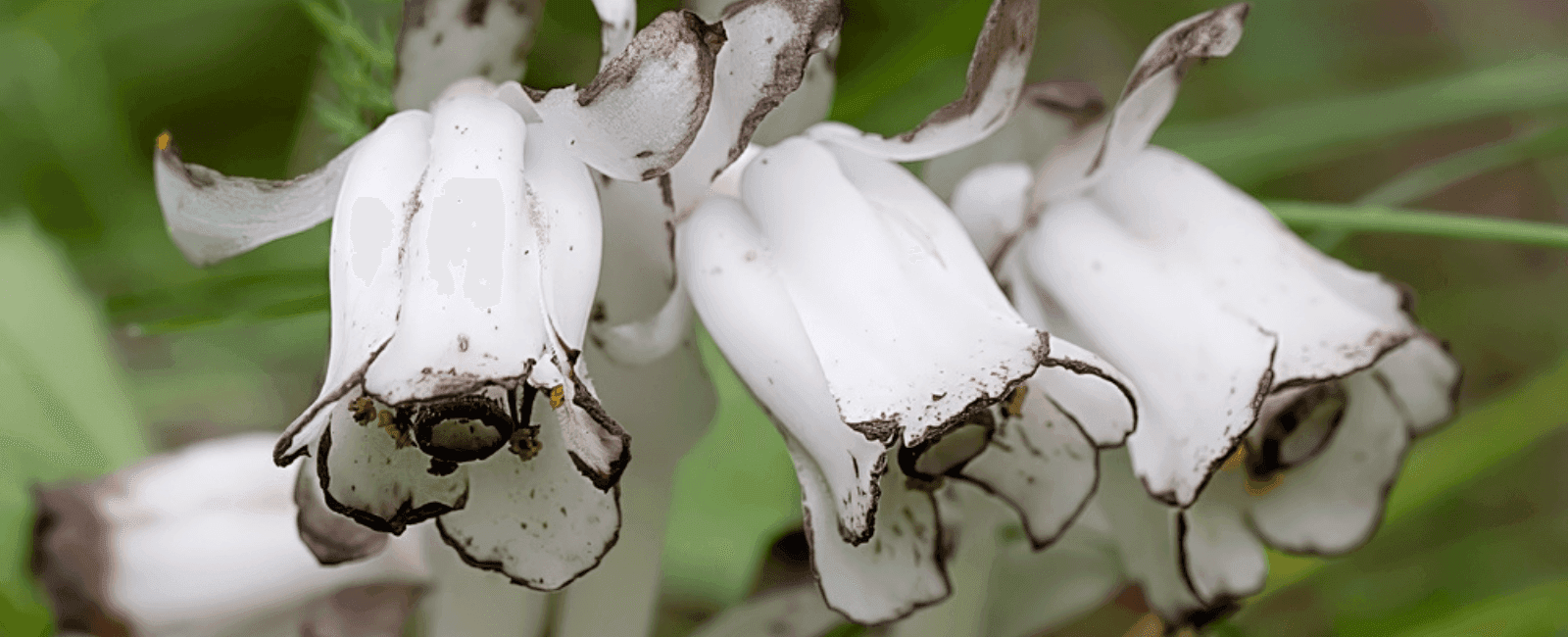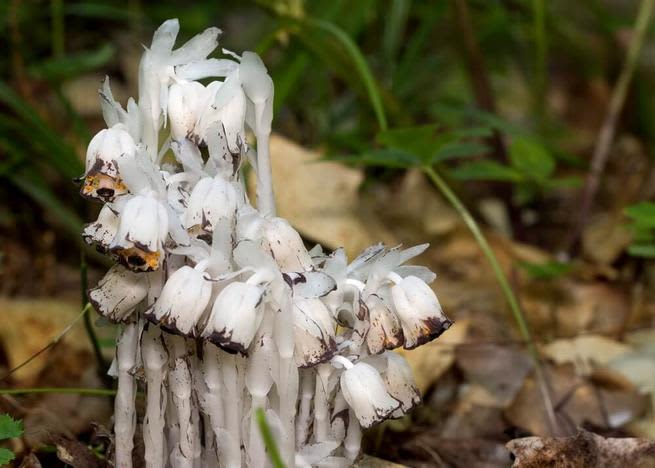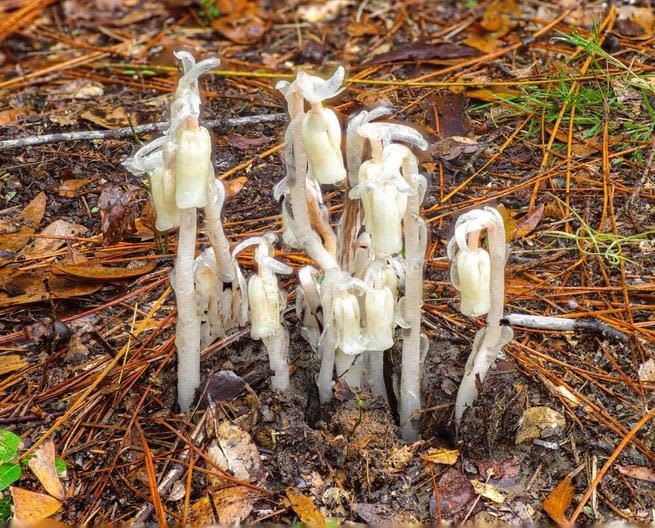

I’ve been ruminating on love lately and what it means to entwine two into one. Ever since mushrooms and fungi wove their way into my life, it is impossible to miss the signs of connection around us. I’m also one month married, which was an experience of not just partnership, but community. And perhaps this is why ghost plant seems a fitting totem for this period of life.
Ghost plant, Monotropa uniflora (Ericaceae), is also known as Indian pipe, ghost pipe, or corpse plant. This wildflower is widely distributed as a native plant throughout Asia, North America, and northern South America, but is still quite rare to uncover in the woods. Surprisingly, it’s not found in the Rocky mountains and southwest of the United States. All other regions of the country, however, from Maine to California and even Alaska have reported the presence of this perennial plant.
They’re noticeable among the humus, or leaf litter, standing about 4-8 inches tall, with small scale-like leaves and five parted flowers. This ghoulish creative thrives in the understory of dark, dense forests where little to no light reaches. Blooms are usually found from early summer to early autumn. (1) When you encounter a drooping, downturned flower, you’ve spotted it before pollination. Afterwards, the flower lifts its beautiful head up, revealing its pink coloration and oval-like center.

This is one of the rare cases where the scientific name tells us little. Usually names are full of colors, movements, shapes. Here, scholars cut to the chase: “monotropa” is the genus name which, in Greek, means “one turn” and “uniflora” is Latin for “one flowered.”
Ironic because these ghostly plants are usually found in small clusters of two or more, so while one flower with an orange-pink center and black specks blooms, rarely is it found alone. This is made even more ironic because their single flower is the least interesting thing about them in the shady woods. The Western name they’ve adapted of ghost plant or ghost pipe fits the eerily translucent, somberly weeping bodies that pull from the underworld, quite literally.
Instead of relying on photosynthesis like its fellow flowering plants, this rare plant pulls its nutrients from neighboring trees through fungi in a process call mycoheterotrophy. That’s what gives this cerebral plant its milky white color — chlorophyll is the secret ingredient that makes plants green.
The cystidia, or the little hairs of ghost plant’s roots, wrap around the mycorrhizal fungi, or hyphae, that grows symbiotically with nearby tree roots, slowly gaining nutrients. It belongs to the Monotropaceae family, or Heath family, which includes Coralroot Orchids (Corallorhiza spp.), Ghost Orchids (Dendrophylax lindenii), Gnome Plant (Hemitomes congestum), and Dutchman’s Pipe (Monotropa hypopitys). This is known as a mycoheterotroph family based on their ecology.

It wasn’t until 1885 that Western science had a term for this network of fungi in the soil of the forest and how it served the whole ecosystem from German botanist Albert Bernhard Frank. It was another 75 years until, in 1960, Swedish botanist Erik Björkman tracked “sugars laced with the radioactive carbon-14 isotope to trace how nutrients move between trees and nearby ghost pipes via the underground fungi.” (2)
The Wood Wide Web of fungi isn’t just a cute, fitting name from Winnie the Pooh. It’s a description of the nearly 90% of plants that obtain key nutrients through mycorrhizal fungi. Not all need to be mycoheterotrophic plants to benefit from this network.
Speaking of names, Indian pipe stems from a Cherokee legend called “The Cherokee Story of Indian Pipe (A Lesson in Humility and Peace).” (3)
The Great Smoky Mountains
Before selfishness came into the world, which was a long time ago, the Cherokee happily shared the same hunting and fishing lands with their neighbors. However, everything changed when selfishness arrived. The men began to quarrel with their neighbors.
The Cherokee began fighting with a tribe from the east and would not share the hunting area. The chiefs of the two tribes met in council to settle the quarrel. They smoked the tobacco pipe but continued to argue for seven days and seven nights.
The Great Spirit watched the people and was displeased by their behavior. They should have smoked the pipe after they made peace. The pipe is sacred and must be treated with respect. He looked down upon the old chiefs, with their heads bowed, and decided to send reminders to the people.
The Great Spirit transformed the chiefs into white-gray flowers that we now call “Indian Pipe.” The plant grows only four to ten inches tall and the small flowers droop towards the ground, like bowed heads. Indian Pipe grows wherever friends and relatives have quarreled.
Next the Great Spirit placed a ring of smoke over the mountains. The smoke rests on the mountains to this day and will last until the people of the world learn to live together in peace. That is how the Great Smoky Mountains came to be.
— Lloyd Arneach (Eastern Band of Cherokee)

The herbaceous perennial is also said to grow where friends have quarreled, in a modern take on the above. Ghost pipe plant has even made its way into the arts, appearing in many of Emily Dickinson’s poems, as Barbara Mallonee beautifully points out. Dickinson referred to it as “the preferred flower of life.” Dickinson fans will remember that she famously wore white, much like our beloved Indian pipe here.
For centuries, indigenous cultures worldwide have used Indian pipe as an a nervine and analgesic, or a homeopathic method to relieve pain without a loss of consciousness. The root is collected, and the juice of the plant is used to treat inflammation, ulcers, and gonorrhea. (4)
These pain-relieving properties are mostly used in mental health today. Those who use ghost pipe tend to do so in tincture form to help with anxiety, low mood, and even as a soothing agent during a bad psychedelic trip.
You can make your own ghost pipe tincture, or you can buy from a trusted source. Over-collecting is a concern in the wildcrafting community, especially as psychedelics become mainstream and Indian pipe continues its reputation for being a lightweight antidote to a bad trip. It’s such a delicate plant that once pulled, it likely won’t grow back.
Many wildcrafters are speaking out against gathering the plant so that its natural abundance remains, especially in the face of climate change and drought-like conditions in forests around the world. (5)

I’ve used Psilly Girls’ Ghost Pipe Tincture for almost one year now and add a few drops to my teas or under my tongue when I’ve felt especially anxious. This is usually during my period when my hormones have leapt out of whack and I’ve felt despondent.
Originally, it was recommended to me by Soma Phoenix, the founder of Psilly Girls, at Psychedelic Science because I was so interested in her herbal tinctures. While I don’t use it consistently, I can feel the onset of taking it within 30 minutes to an hour after ingesting. In my experience, it’s a soothing calm that descends over my mental state, one that feels alleviating but not jarring in its presence.
Ghost plant is one that relies upon community and cannot survive without those trees and fungi around it. A beautiful gift emerging from the Earth, it feels so much like a symbol of what comes with peace and collaboration, a legend long before Western science tracked sugars through roots.
In peace and community, there is surrender. A gentle jolt of acceptance and tenderness that allows one to feel safe. It’s no wonder what ghost pipe does for us and our bodies when you consider the great stillness of calm.
References
- “U.S. Forest Service.” Forest Service Shield, www.fs.usda.gov/wildflowers/beauty/mycotrophic/monotropa_uniflora.shtml. Accessed 9 Apr. 2024.
- Popova, Maria. “The Poetic Science of the Ghost Pipe: Emily Dickinson and The Secret of Earth’s Most Supernatural Flower.” The Marginalian, 30 Aug. 2023, www.themarginalian.org/2023/08/23/ghost-pipe/.
- Arneach, Lloyd. “The Cherokee Story of Indian Pipe.” Indian Pipe, wsharing.com/WSphotosIndianPipe.htm. Accessed 9 Apr. 2024.
- “Provings - School of Homeopathy - Ghost Pipe (Monotropa Uniflora).” The School of Homeopathys RSS, www.homeopathyschool.com/the-school/provings/indian-pipe/. Accessed 9 Apr. 2024.
- Christina Every Leaf Speaks Botanical Studies. “Ghost Pipe, a No Pick.” Everyleafspeaks.Org, Everyleafspeaks.org, 14 Aug. 2019, www.everyleafspeaks.org/blank-3/ghost-pipe-a-no-pick.


